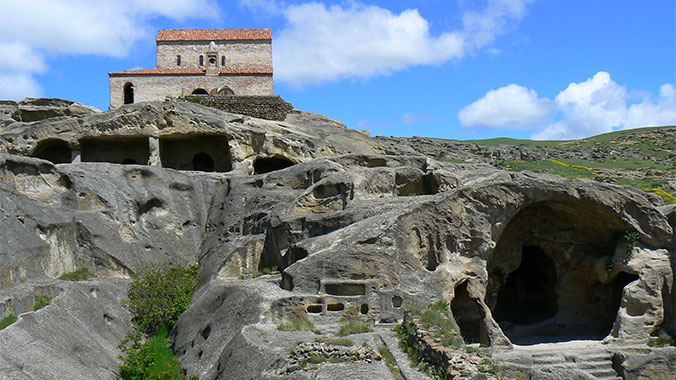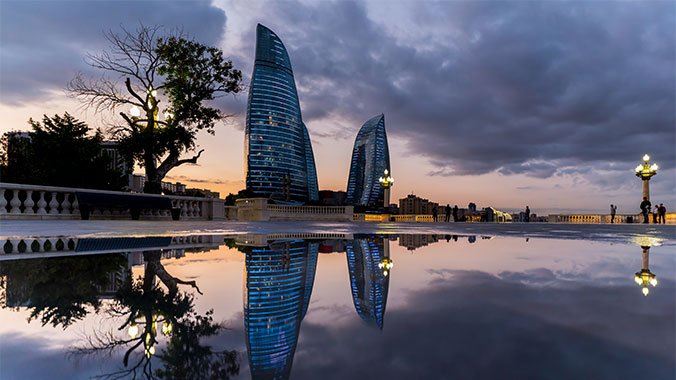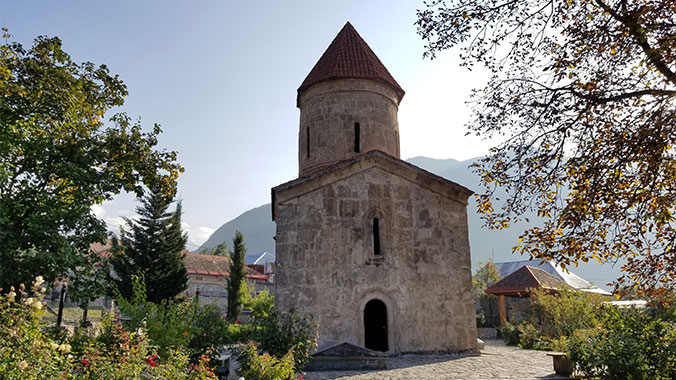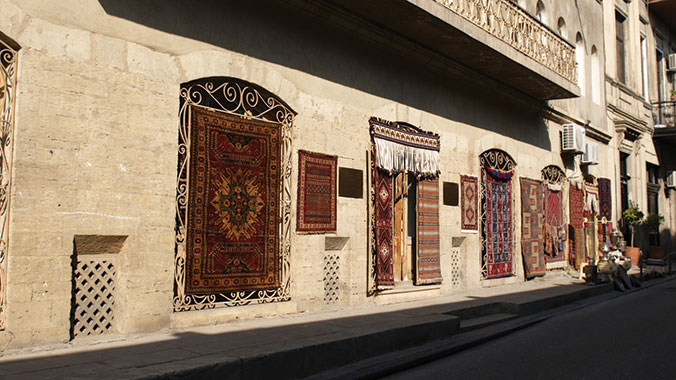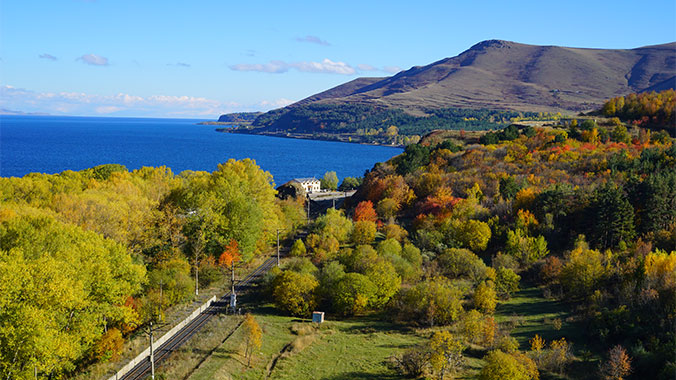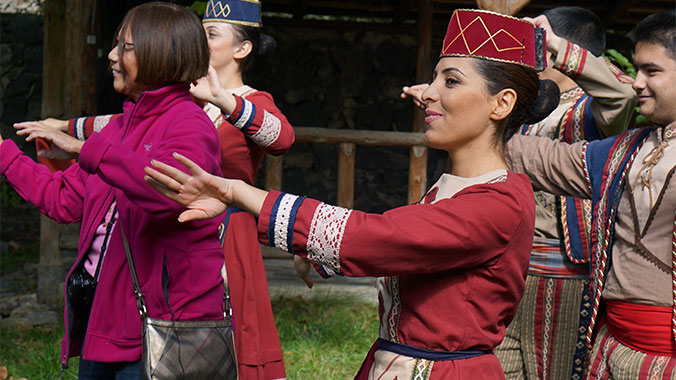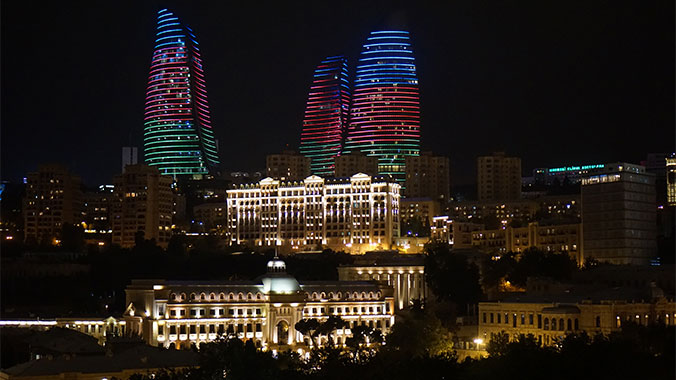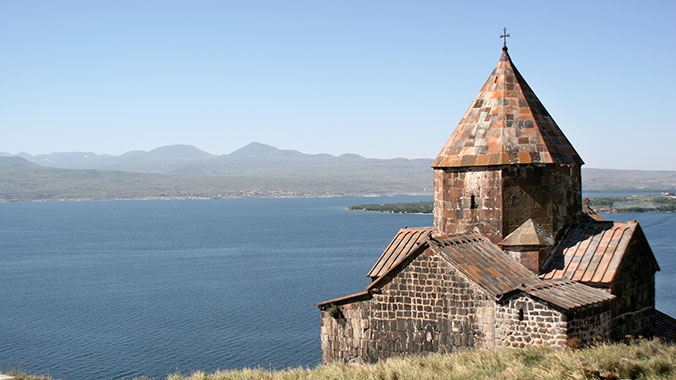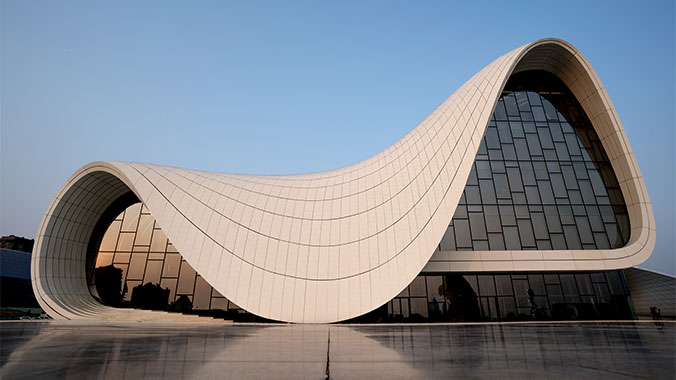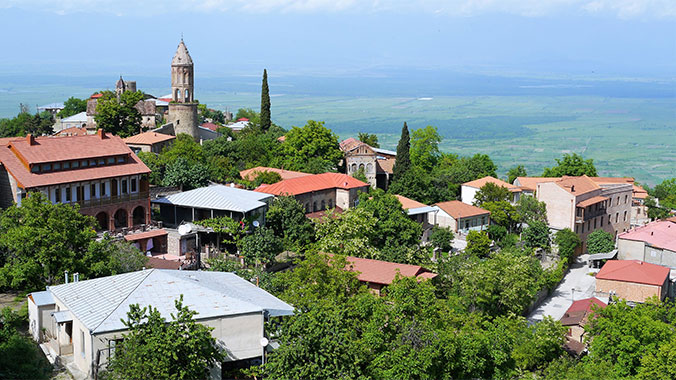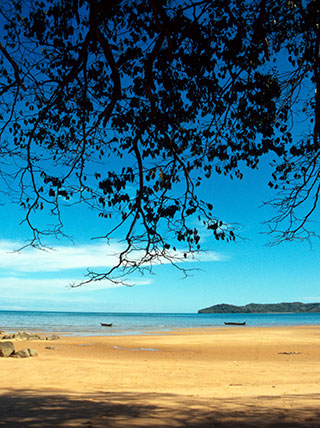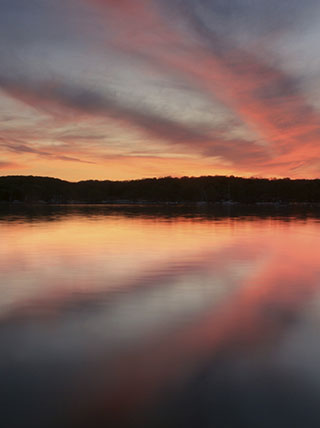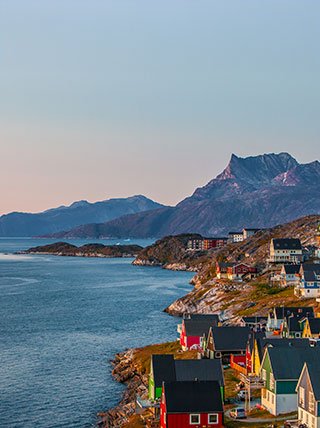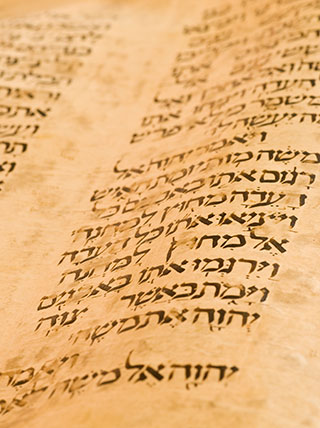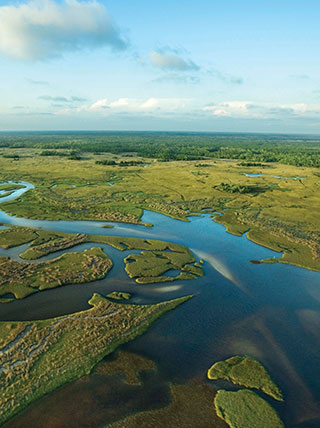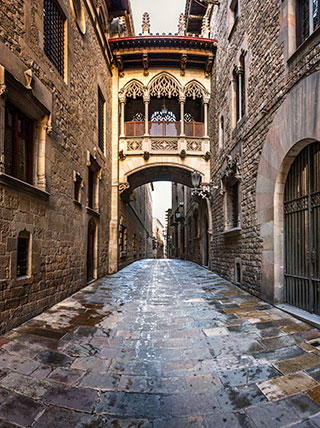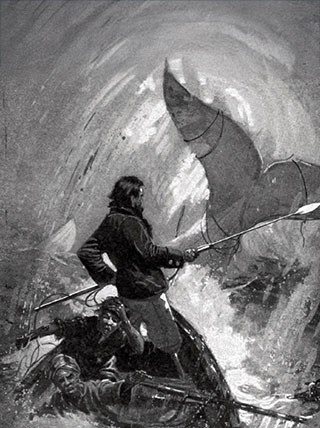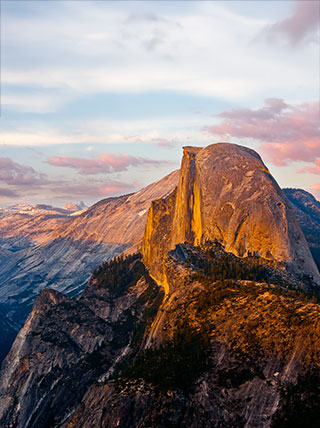Azerbaijan/Georgia/Armenia
South Caucasus Odyssey: Azerbaijan, Georgia and Armenia
Program No. 16908RJ
Gain a deeper understanding of the South Caucasus as you visit sacred monuments, sample traditional cuisine, attend cultural performances and learn the story of this ancient region.
Enroll with Confidence
We want your Road Scholar learning adventure to be something to look forward to—not worry about. Learn more
Protecting the Environment
We offset a portion of the emissions created by your travel. Learn more
Itinerary
While we make every effort to ensure the accuracy of our published materials, programs are typically advertised more than a year prior to their start date.
Read More.
While we make every effort to ensure the accuracy of our published materials, programs are typically advertised more than a year prior to their start date. As a result, some program activities, schedules, accommodations, personnel, and other logistics occasionally change due to local conditions or circumstances. Should a major change occur, we will make every effort to alert you. For less significant changes, we will update you during orientation. Thank you for your understanding.
Duration
15 days
14 nights
What's Included
32 meals (
13B, 12L, 7D
)
5 expert-led lectures
35 expert-led field trips
1 hands-on experience
4 performances
An experienced Group Leader
13 nights of accommodations
Taxes and customary gratuity
Road Scholar Assurance Plan
Day
1
In Transit to Program
Location:
In Flight
Day
2
Arrive Baku, Check-in
Location:
Baku
Stay:
Radisson Hotel Baku
Activity Note
Hotel check-in from 2:00 p.m. Remember to bring your nametag (sent previously). The altitude in central Baku is -91.9'.
Evening:
After arriving at the hotel and getting your room assignment, settle in and get a good night’s rest for the day ahead.
Day
3
Orientation, Old City, Carpet Museum, Heydar Aliev Center
Location:
Baku
Meals:
B,L,D
Stay:
Radisson Hotel Baku
Activity Note
Getting on/off a bus; driving about 15 miles over the day, mostly in city. Walking about 2 miles, approximately 2-2.5 hours; uneven and hard surfaces. Shirvan Shah Palace has some uneven and rough steps with no handrails.
Breakfast:
At the hotel.
Morning:
Orientation: 9:00 a.m. The Group Leader will greet everyone and lead introductions. We will review the up-to-date program schedule, discuss roles and responsibilities, logistics, safety guidelines, emergency procedures, and answer questions. We will learn from the Group Leader as well as local experts who will give lectures and lead field trips. Program-related travel and transfers will be via private bus unless noted otherwise. Periods in the schedule designated as “Free time” and “At leisure” offer opportunities to do what you like and make your experience even more meaningful and memorable according to your personal preferences. The Group Leader will be happy to offer suggestions. Program activities, schedules, personnel, and indicated distances or times may change due to local circumstances/current conditions. In the event of changes, we will alert you as quickly as possible. Thank you for your understanding. We will then set out to explore Baku’s Old City, Icheri Sheher, with a local expert. Once the whole city, this is the best place to get a sense of Baku's history. It is completely encircled by the old city walls with their medieval gates. The winding streets and alleyways are home to private residences, mosques and madrassahs, carpet merchants and tiny shops. We will pass by the UNESCO-listed Maiden’s Tower and Shirvan Shah Palace.
Lunch:
At a local restaurant.
Afternoon:
We will explore the interior of the Heydar Aliyev Cultural Center, a landmark of modern Baku. Opened in 2012, the center houses an innovative performing arts auditorium and spaces for major art exhibitions. The 619,000-square-foot building was designed by famed Iraqi-British architect Zaha Hadid, one of the most influential architects of the 20th and 21st centuries and the award-winning master behind such buildings as the London Aquatics Center, the Rosenthal Center for Contemporary Art in Cincinnati, Ohio, and the Guangzhou Opera House in China. Inside the center we will learn from a local expert about the history and culture of Azerbaijan and enjoy some free time to independently browse the exhibitions. The vivid colors and bold designs of Azeri, Caucasian and Iranian carpets are on display at the State Museum of Azerbaijani Carpets and Applied Folk Art. The museum collection was begun in the late 1960s, but the carpets in the museum today date as far back as the 16th century. Regional differences and stylistic details are highlighted, revealing how traditional carpets marry practical value, artistic merit, historical significance and beauty.
Dinner:
At a local restaurant. Over dinner, we’ll meet a local expert and enjoy a lecture on current affairs.
Evening:
At leisure.
Day
4
Baku, To Sheki
Location:
Sheki
Meals:
B,L,D
Stay:
Macara Hotel
Activity Note
Getting on/off a bus; morning driving about 25 miles, approximately 1.5 hours riding time to Gobustan with a stop at Bibi Heybat Mosque. The Gobustan visit will take about 1 hour; walking tour outdoors with uneven steps and no handrails and a visit to the indoor museum; surfaces at Gobustan may be slippery on rainy days. Afternoon driving about 165 miles to Sheki, approximately 3-4 hours riding time. The highest altitude today will be 2625'.
Breakfast:
At the hotel.
Morning:
We’ll depart by private bus to Sheki making several stops along the way. We will stop at Bibi-Heybat Mosque, originally constructed in the 13th century and completely destroyed in 1934 by Stalin’s decree. Local legends say that a white-robed woman was seen disappearing into the sea the day after the mosque’s destruction. Reconstructed from plans and photographs, the new mosque was dedicated in 1998. Today it sits near one of Azerbaijan’s first oil fields, developed during the first oil boom in the late 19th and early 20th centuries. Next, we’ll go to Gobustan, an important site of ancient petroglyphs, added to the UNESCO World Heritage list in 2007. Quarry workers discovered the rock carvings here by accident in the 1930s. Since then, the carvings depicting men, women, animals and artifacts have been the focus of much study and speculation. An excellent modern museum adds to the experience.
Lunch:
At a local restaurant.
Afternoon:
We’ll stop in Shamakhi, former capital of the once-powerful Shirvan Khanate from the 6th to the 15th centuries. Explore the town, passing by the 10th-century Djuma Mosque, the oldest mosque in the Caucuses. We’ll continue on the bus to Sheki, arriving in the evening.
Dinner:
At the hotel.
Evening:
At leisure.
Day
5
Sheki, Khan’s Palace, Free Time
Location:
Sheki
Meals:
B,L,D
Stay:
Macara Hotel
Activity Note
Walking approximately 2.5-3 hours in the morning. Old Town of Sheki is mostly cobblestone surfaces; there are several steep stairs in the Khan’s Palace with no handrails. Extent and duration of walking and other activities during free time according to personal choice.
Breakfast:
At the hotel.
Morning:
We’ll go on a walking field trip through charming Sheki, led by a local expert. Founded some 2,700 years ago, Sheki is among the oldest settlements in Azerbaijan. Our exploration of Sheki includes a visit to the mosaic-covered Khan's Palace with its brilliant stained-glass work, the fortress that surrounds the palace, the History and Crafts Museums, and a walk of local craft shops and bakeries.
Lunch:
At a local restaurant.
Afternoon:
Free time. This period of time has been set aside for your personal independent exploration to see and do what interests you most. Please refer to the list of Free Time Opportunities. The Group Leader will be happy to offer suggestions. Please note that the period scheduled for free time is subject to change depending on local circumstances and opportunities for independent exploration.
Dinner:
At a local restaurant with traditional Azeri musical entertainment. Musical history in Azerbaijan dates from before 3000 BCE. Its most well-known form is mugham, a fusion of Persian and Turkic traditions honored as a World Cultural Masterpiece by UNESCO. This mesmerizing music is usually sung, accompanied by traditional instruments. Ancient and modern poems, in the Azeri, Persian, and Arabic languages are set to music, using a subtle scale of 84 micro-intervals and no time signature. The resulting unwritten pieces are passed by ear through generations to provide the improvisational bases for the songs.
Evening:
At leisure. Prepare for check-out and transfer in the morning.
Day
6
To Telavi, Georgia
Location:
Telavi
Meals:
B,L
Stay:
Holiday Inn Telavi
Activity Note
Getting on/off a bus; driving about 145 miles, approximately 4 hours riding time with Azerbaijan/Georgia border crossing. The bus will park near to all visited sites and there will be minimal walking. There are some stairs without handrails inside the yard of the Bodbe monastery. The town of Signagi and the winery are on hills and participants will walk a short distance on an uneven cobblestone road. The altitude in Telavi is about 2,600'.
Breakfast:
At the hotel.
Morning:
We will check out and depart by bus for Georgia. After the border crossing formalities, we’ll meet our Georgian guide and change to a local bus. We will travel through the Kakheti region, the most important wine-grape-growing area of the country. Georgian wine is well regarded throughout the world and some of the country's best comes from Kakheti. We’ll visit the Pheasant’s Tears Winery, producing organic wines from varietal grapes that grow well in the Kakhetian micro-region. The name of the winery comes from a Georgian legend in which the hero claims that it takes a “wine beyond measure” to make a pheasant cry tears of joy. The owner is an American man. We’ll sample wines from Georgia’s famous wine region at a tasting.
Lunch:
At the winery.
Afternoon:
We’ll go on a walk through the beautiful hill town of Signagi, known for its cobbled old town square, the nearby Bodbe Nunnery, and the remnants of an impressive 18th-century defensive wall that still surrounds part of the city. The wall’s towers were named for the nearby villages, and the townspeople were meant to gather at their tower in times of trouble. Wander the narrow streets and admire the richly carved balconies and the green Alazani valley below. We’ll then meet with women from the Nukriani Community Organization, who make chewy Georgian sweets called churchkhela, and also sell natural jams, nuts, and handmade local natural products. Nukriani is a small town located near Signagi. Here we’ll enjoy a class on making felt. At the nearby Lost Ridge Inn & Brewery, we’ll taste Georgian craft beers and local snacks.
Dinner:
On your own this evening.
Evening:
At leisure.
Day
7
Tsinandali, Chavchavadze Estate, Alaverdi Cathedral
Location:
Telavi
Meals:
B,L,D
Stay:
Holiday Inn Telavi
Activity Note
Getting on/off a bus; the bus will park near to all sites visited today to minimize walking. There will be about 2 hours of driving in total. The drive from Telavi to Tsinandali is about 15 miles, approximately 1/2 hour riding time each way. There are some stairs inside the Chavchavadze Estate Museum and at Alaverdi.
Breakfast:
At the hotel.
Morning:
We will head out by bus to visit Tsinandali village, best known for the family estate of Alexander Chachavadze, led by the Group Leader. A 19th-century Georgian aristocrat and poet, Chachavadze managed to serve admirably in the Imperial Russian army during the times he wasn’t fighting Russia for Georgian independence. His estate was a center of the intellectual life of the time. Here, he and his father founded the first and foremost winery in the country, which still produces the dry white Tsinindali wine. His mansion has been transformed into a museum in honor of the poet and hero. We’ll continue to Alaverdi Cathedral, one of the tallest churches in Georgia and, in its simplicity, one of the most striking. One of the 13 Syrian Fathers, Joseph of Alaverdi, established the first church here.
Lunch:
We’ll drive to the village of Alvani, gateway to the Tusheti highlands of Georgia, and enjoy a traditional Georgian Table in a private home – an unforgettable opportunity to taste authentic Georgian dishes and local wines while regional performers entertain. We’ll also see a demonstration of traditional bread baking and vodka distilling.
Afternoon:
We will stop in at the workshop of a ceramicist who makes qvevri, the 200- to 900-gallon earthenware vessels used for fermenting and storing Georgian wines. Because of the increasing interest in natural traditional-made wines, the demand for qvevri has increased greatly in recent years. The ceramicist will demonstrate and explain the qvevri-making process and present the resulting vessels.
Dinner:
At a local restaurant.
Evening:
At leisure. Prepare for check-out and transfer in the morning.
Day
8
To Tbilisi, Old Town
Location:
Tbilisi
Meals:
B,L,D
Stay:
Courtyard by Marriott Tbilisi
Activity Note
Getting on/off a bus; the bus will park near to all sites visited today; driving about 100 miles, approximately 2 hours total riding time. Afternoon walking around Old Town Tbilisi, which will include some periods of walking and standing on hard surfaces; some sites involve 10-20 stairs with and without handrails; many stops. The highest altitude today is Tbilisi at 2,530'.
Breakfast:
At the hotel.
Morning:
Checking out of the hotel, we’ll drive by private bus to Tbilisi.
Lunch:
At a local restaurant upon arrival in Tbilisi.
Afternoon:
Spend the rest of the day getting to know Tbilisi, Georgia’s gorgeous capital city, on a combination walking and driving tour. Georgia’s strip of central lowlands has long been an important link between East and West. Tbilisi is set at the mouth of this passageway, in the Mtkvari River valley, and has changed hands many times. Most notably, the Arabs ruled the city for 400 years before King David the Builder defeated them in 1121 and moved his capital here from Kutaisi. The Georgian king fostered tolerance for Tbilisi’s Arab population, and the city still has a multiethnic atmosphere. The red-roofed old town, its houses sporting carved wooden balconies, sits beneath the Narikala Fortress on the hill above. Tbilisi was last razed in 1795 by Aga Khan, and most of the current buildings date from that time. The domed sulfur baths and the stone Anchiskhati Church where all that survived. View the 13th century Metekhi Church of the Virgin, constructed on an outcropping above the river on the site of David the Builder’s former palace. See Tbilisi’s earliest sulfur baths, probably built during Arab rule in the 7th or 8th centuries, when hot springs were discovered just under the surface of the old part of Tbilisi. In the 13th century there may have been up to 68 baths in Tbilisi; now there are six or seven. Most of the baths in use today were built in the 17th century. Pedestrians can see steam issuing from the dome-shaped underground baths as they pass by. Pause at Sioni Cathedral, sheltering the Cross of St. Nino, the woman who brought Christianity to Georgia, and the 19th century caravanserai built to house traveling merchants. Take time to briefly stroll Rustaveli Avenue, the city’s main street. Notice the numerous elaborately carved wooden balconies attached to the houses in the Old Town, a feature of the city's architectural landscape that often appears in paintings. Stop in to visit a working bakery.
Dinner:
At a local restaurant in Tbilisi with musical entertainment.
Evening:
At leisure.
Day
9
National Museum of Georgia, National Art Gallery, Free Time
Location:
Tbilisi
Meals:
B,L
Stay:
Courtyard by Marriott Tbilisi
Activity Note
Walking on city streets from hotel to museums. Inside museums, walking up and down stairs and periods of standing while looking at exhibits and listening to expert’s explanations. No elevators inside museums. Extent and duration of walking and other activities during free time according to personal choice.
Breakfast:
At the hotel.
Morning:
We’ll start the morning with a guest lecture from a local Tbilisi resident. Following the lecture, with the Group Leader, we’ll visit some of Tbilisi’s best museums: the Georgian National Museum with one of the largest collections of ancient gold decorative arts as well as very well-preserved medieval cloisonné; the Museum of Soviet Occupation, which was created to commemorate the almost 900,000 Georgians who were killed or deported during the Soviet years of 1921 to 1991; and the Georgian National Art Gallery.
Lunch:
At a local restaurant.
Afternoon:
Free time.
Dinner:
On your own to enjoy local fare.
Evening:
At leisure.
Day
10
Mtskheta, Svetitskhoveli, Jvari, Dry Bridge Market
Location:
Tbilisi
Meals:
B,L
Stay:
Courtyard by Marriott Tbilisi
Activity Note
Getting on/off a bus; driving 20 miles to Mtskheta, under 1 hour riding time. Participants will spend about 2 hours on foot walking around cobblestone streets and visiting insides churches and cathedrals. There are some stairs and uneven pavement to reach the scenic view point in Jvari.
Breakfast:
At the hotel.
Morning:
We’ll begin the day with an expert-led lecture at the hotel. We’ll then ride to Mtskheta, the capital of the eastern Georgian kingdom of Iberia from the 3rd century BCE until the 5th century CE. Because of its location at the confluence of the Kura and Aragvi rivers, it was an important market town. As the center of the Iberian civilization, Mtskheta was also significant spiritually and culturally. Georgia’s conversion to Christianity took place here in 337 CE, and the Orthodox churches built during this period are considered among the finest in the country. Mtskheta is designated as a UNESCO World Heritage Site. Our visits in Mtskheta include the 11th-century Svetitskhoveli Cathedral, its interior decorated in murals, and the 6th-century Jvari Monastery, containing one of the first Christian churches in Georgia. The cross-shaped church at the Holy Cross Monastery of Jvari was built over the spot where St. Nino erected the first wooden cross in Georgia.
Lunch:
At a local restaurant.
Afternoon:
We will have the opportunity to join a walking field trip with the Group Leader through the Dry Bridge Market, where vendors sell wares that run the gamut from jewelry, tchotchkes, carpets, and tableware to car parts and tools. Paintings and handicrafts are exhibited in a small park nearby.
Dinner:
On your own to enjoy local fare.
Evening:
At leisure. Prepare for check-out and transfer in the morning.
Day
11
Drive to Yerevan, Lake Sevan
Location:
Yerevan
Meals:
B,L,D
Stay:
Hilton Doubletree Yerevan
Activity Note
Getting on/off a bus; driving about 200 miles, approximately 5-6 hours total riding time from Tbilisi to Yerevan. Including the border crossing, lunch, and visits along the way, it will be an all-day drive leaving Tbilisi after breakfast and arriving in Yerevan before dinner. The altitude at Lake Sevan is about 6,234'. The altitude in Yerevan is about 3,248'.
Breakfast:
At the hotel.
Morning:
We’ll say goodbye to Georgia and continue to Armenia. We’ll meet our Armenian guide, change to the local bus at the border, and drive to the Haghbat Monastery Complex, founded in the 10th century. This fortified monastery, added to over two hundred years, was a literary, artistic and educational center as well as a monastic compound. Comprised of atmospheric stone churches, bell towers, mausoleums and numerous khachkar (carved stone crosses), Haghbat is a UNESCO World Heritage Site. This monastery is an outstanding example of the blending of Byzantine church architecture with the local Caucasian architecture of the period.
Lunch:
At a local restaurant.
Afternoon:
Continuing to Yerevan, we’ll make a stop at Sevanavank Monastery located on stunning blue-green Lake Sevan, at over 6,200 feet above sea level, one of the largest alpine lakes in the world. Filling two intermountain depressions, the brilliant lake is a favorite resort for citizens of Yerevan, about 45 miles away. Located on a peninsula that was once an island in Lake Sevan, the Sevanavank Monastery is made up of two remaining churches – the Church of Saint Astvatsatsin and the Church of Saint Arakelots – though it was a much large compound at one time and ruins of other buildings can be seen. The monastery was founded in the year 874 CE and was an important center of pilgrimage for Armenian Christians throughout the Middle Ages. Some of the artifacts from the monastery, such as its 12th-century carved wooden doors, are preserved in the State History Museum in Yerevan, but visitors to the site should note the carved green khachkars.
Dinner:
At a local restaurant upon arrival in Yerevan.
Evening:
At leisure.
Day
12
Discover Yerevan, Cascade, Genocide Museum & Memorial
Location:
Yerevan
Meals:
B,L
Stay:
Hilton Doubletree Yerevan
Activity Note
A walking tour on city streets and transfers by bus between other sites. Getting on/off a bus; city driving. The bus will park next to all sites visited today to minimize walking distances. To visit the eternal flame at the Genocide Memorial there is a long flat walking surface and some stairs without handrails involved. The altitude in central Yerevan is about 3,248'.
Breakfast:
At the hotel.
Morning:
We’ll begin the day with a lecture by a local expert about Armenia’s current affairs. Afterwards, we’ll depart on an expert-led exploration of Yerevan, the capital of Armenia, a city older than Rome. We will first stop at the weekend Art Park, Vernisage, the best opportunity for people watching. Here one can find a wide assortment of woodcarvings, ceramics, jewelry, paintings and other high-quality souvenirs. Located in Republic Square, the State History Museum features ancient models of Yerevan, archaeological collections from the Stone Age, and the statues of Catherine the Great and a beheaded Lenin tucked into its back courtyard. It also contains 10,000 original photographs and 5,000 historical documents that chronicle Armenia’s story. The museum recently acquired its current home following a ten-year stint in an obscure building, a period of homelessness and the repossession of the mosque it once occupied. The giant “Cascade” stairway links central Yerevan to the Mother Armenia Statue in Victory Park. The top of the Cascade and along the stairway offer fantastic views of Yerevan and Mt. Ararat on a clear day. Modern sculptures dot the outside of the structure, including signature pieces by Colombian sculptor Fernando Botero and Barry Flanagan. The Cafesjian Museum of Modern Art, built on the extensive collection of Gerard Cafesjian, is located inside and focuses on sculpture, glass, and paintings from contemporary artists. We’ll ride the escalators towards the top of the stairway and walk the rest of the way up until we reach the Mother Armenia statue. Designed so that its interior resembles the iconic St. Hripsemeh Church at Echmiadzin, the base of this 167-foot monument was first used as a museum dedicated to WWII. In 1995, it was renamed the Military Museum of Mother Armenia; it includes exhibits pertaining to the Nagorno-Karabakh war.
Lunch:
At a local restaurant.
Afternoon:
We will visit the Armenian Genocide Memorial in a park at the top of Tsitsernakeberd, or “Swallow Castle.” According to scholarly estimates, over one million Armenians perished due to the policies of the last Ottoman government between 1914 and 1918. Thousands were deported to Syria and faced consequent starvation, while others were methodically massacred. Many of the remaining Armenians fled to other countries in what is now called the Armenian diaspora. The Genocide Memorial Museum provides a historical background to the monument.
Dinner:
On your own.
Evening:
At leisure.
Day
13
Temple of Garni, Geghard Monastery
Location:
Yerevan
Meals:
B,L,D
Stay:
Hilton Doubletree Yerevan
Activity Note
Getting on/off a bus; driving 40 miles one-way; approximately 1 hour riding time. The bus will park near to the sites and there will be minimal walking distances. The highest altitude reached today will be Geghard Monastery at about 6,273'.
Breakfast:
At the hotel.
Morning:
We will learn about Armenia’s spiritual history on a day trip to the religious centers of Garni and Geghard. Carved into the side of a mountain, Geghard Monastery is one of the most fascinating monuments in Armenia. Beside the river at the foot of the rock, the church dates from 1215. It provides access to another building that has a roof formed by stalactites. The convent is in a cave adjoining this building; the only way in is through a narrow opening in the roof. The compound includes monastic cells, churches, tombs, and khachkar, all hewn from solid rock. The churches are still functioning and for special events, such as baptisms, sacrifices of lambs sometimes take place. We will enjoy a concert of sacred music performed a capella. Next, we’ll visit the Temple of Garni, standing on a cliff near the Azat River valley with walls of huge basalt blocks; the temple was once the summer palace of King Trdat I, who built it in the first century CE. Destroyed by an earthquake in 1679, the monument has been restored by Armenian architects in recent years, and skilled work continues on the third-century royal baths and their striking mosaics. Armenia is famous for the intricately carved stone crosses known as khachkar. These masterpieces can be found in various parts of the country. They are a unique art form, distinct to Armenia, which originally appeared in both pagan and Christian periods. Initially wooden, the first stone crosses appeared in the 4th-7th centuries.
Lunch:
We will visit a private home for a lavash-making demonstration, then taste the fresh bread during lunch here.
Afternoon:
Returning to central Yerevan this afternoon, we will pay a visit to a local fruit and vegetable market, led by a local expert.
Dinner:
At a local restaurant. Share favorite experiences and enjoy camaraderie with new Road Scholar friends during our farewell dinner
Evening:
At leisure.
Day
14
Echmiadzin & Zvartnots Cathedrals, Duduk Studio
Location:
Yerevan
Meals:
B,L
Stay:
Hilton Doubletree Yerevan
Activity Note
Getting on/off a bus; driving 14 miles from central Yerevan to Echmiadzin, approximately 1/2 hour riding time. Some stairs at entrances to cathedrals. Bus will park as close to sites as possible.
Breakfast:
At the hotel.
Morning:
Led by a local expert, we will head out to visit Echmiadzin, founded as Vargarsapat in 117 CE and once the capital of Armenia, known as the spiritual center of Armenia and the seat of its Catholicos, or Patriarch. A UNESCO World Heritage Site since 2000, it is also an important place of pilgrimage for Christian Armenians from the world over. It was here that St. Gregory the Illuminator had a vision of Christ descending to earth, and the Cathedral at Echmiadzin was built on the spot in the 4th century. Today’s version dates from the 7th century and features an intricately carved stone entryway and a fabulous treasury, including a piece of wood from Mt. Ararat said to be from Noah’s Ark. The UNESCO site also includes the ruins of the 7th-century Zvartnots Cathedral, although it is miles away from Echmiadzin. In its day, Zvartnots was the largest round church in the world. It was sacked in the 10th century by Arab invaders, possibly because they wanted no building higher than their own mosque. Nearby Hripsimeh Church sits on the foundations of the 4th-century mausoleum of martyred St. Hripsimeh and was completed in the 7th century. Its complex architecture, unusual for its time, has enabled it to withstand earthquakes. Highlights are the beautifully carved wooden door and the 18th-century mother-of-pearl altarpiece.
Lunch:
At a local restaurant.
Afternoon:
In central Yerevan, we will visit the studio of master craftsman Karen Hakobyan, one of the finest makers of the traditional Armenian reed instrument, the duduk. With a sound somewhat like a clarinet, the duduk’s roots go back several thousand years. The duduk and its music were inscribed on the Representative List of the Intangible Cultural Heritage of Humanity in 2008. We’ll learn about Armenian instruments and enjoy tea or coffee and cake with the master. Return to the hotel, we’ll adjourn for the day to finish preparations for early morning departure.
Dinner:
On your own to allow time for rest before early departing flights.
Evening:
At leisure. Prepare for check-out and departure in the morning.
Day
15
Program Concludes, In Transit From Program
Location:
In Flight
Meals:
B
Activity Note
Hotel check-out by 12:00 Noon, although most flights that connect to the USA depart Yerevan very early in the morning. See your program’s “Getting There” information regarding transfers.
Breakfast:
At the hotel, flight time permitting.
Morning:
If you are returning home, safe travels. If you are staying on independently, have a wonderful time. If you are transferring to another Road Scholar program, detailed instructions are included in your Information Packet for that program. We hope you enjoy Road Scholar learning adventures and look forward to having you on rewarding programs in the future. Don’t forget to like our Facebook page and follow us on Instagram. Best wishes for all your journeys!
Please select a day to update the map
Map details are not available for this location.

